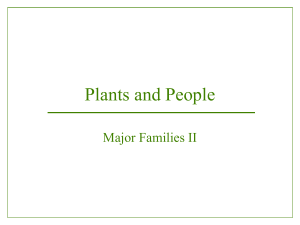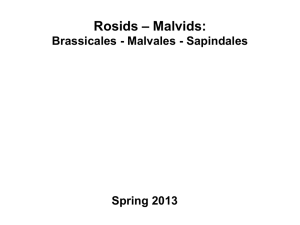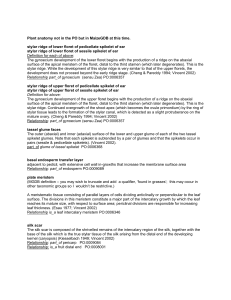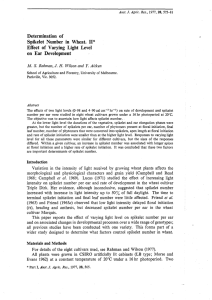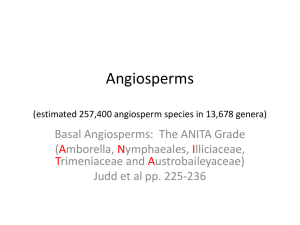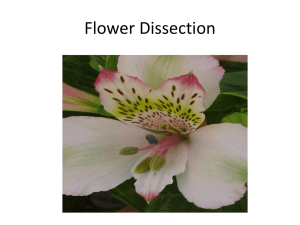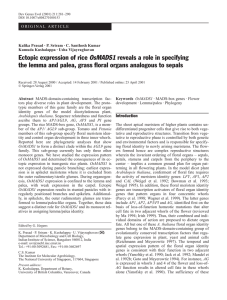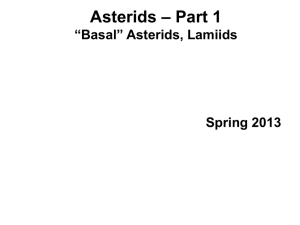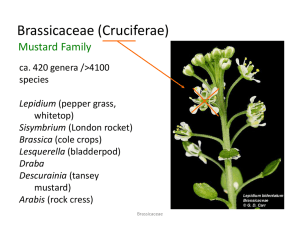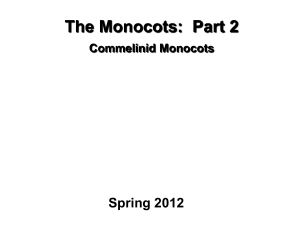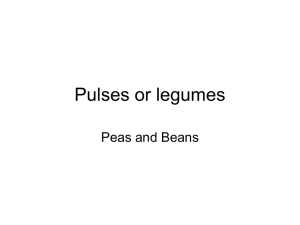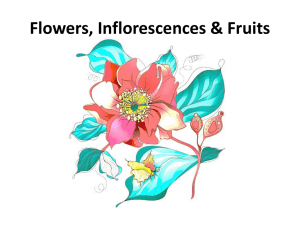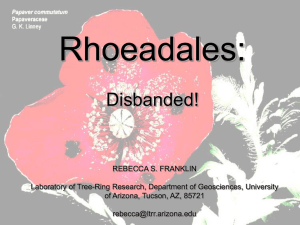here.
advertisement
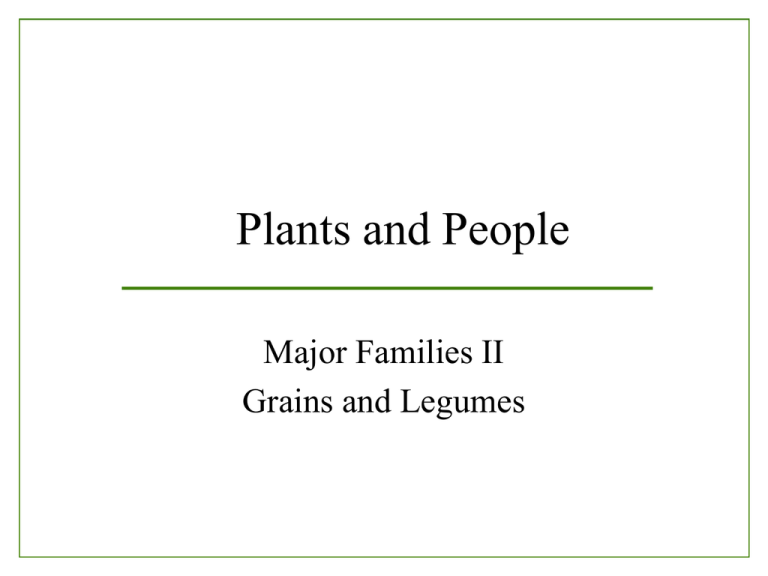
Plants and People Major Families II Grains and Legumes Why grains and legumes? And why together? Grain + legume = complete protein That peanut butter sandwich is looking pretty good now, isn’t it? Poaceae - The Grass Family Humans devote more than 70% of the Earth’s farmlands to the production of cereal grains Grasses provide at least 50% of the world’s caloric intake Some anthropologists are of the opinion that the use of cereal grain was a prerequisite for the formation of a civilization Vegetative Characteristics Grass Inflorescence The spikelet is the basic unit of grass inflorescence, with one or more florets making up the spikelet. The spikelet is subtended by two sterile bracts known as glumes. The glumes define the spikelet: they and everything above them make up the spikelet. Spikelet Floret Glumes Floral Morphology Flowers of the grass family are highly reduced and non-showy and are described using unique terminology. • The perianth has been reduced to structures colled lodicules, located at the base of the ovary (these may be absent) • The mature ovary (fruit) is termed a grain or caryopsis • Each flower is enclosed by two fertile bracts, with the larger, lower bract, the lemma enclosing the usually smaller, upper bract termed the palea • The tip of a glume, lemma or palea may be extended into a bristle-like structure called an awn • The lemma, palea and the flower make up the floret Floral Morphology An oat spikelet: palea 1 palea 2 anthers stigma awn 1 lemma 1 lemma 2 awn 2 glumes The Beans Caesalpiniaceae/ Caesalpinoideae Fabaceae/ Papilionoideae/ Faboideae Legumes Mimosaceae/ Mimosoideae The Bean Families • Everyone agrees that the legumes form a coherent whole based on the presence of a single carpel that matures into a legume. •They can be divided into three groups based on the arrangement and structure of the androecium and perianth, collectively called the androperianth. •The question is whether to : --treat them all as a single family Fabaceae (broad sense) with three subfamilies or --treat them as separate families in the order Fabales. Fabaceae (strict sense), Papilionoideae/Faboideae Flowers in Fabaceae are zygomorphic and papilionaceous (butterflylike). The corolla is consists of 5 petals: a banner, 2 wings, and a fused keel. The banner is exterior to the wings. The fused keel encloses the unique androecium, 10 stamens in 9 fused+ 1 free arrangement (this is termed diadelphous.) The stamens surround the style but are not fused to it. Caesalpiniaceae/ Caesalpinioideae Flowers in the Caesalpiniaceae Family are zygomorphic and papilionaceous (butterfly-like). The corolla is consists of 5 petals: a banner, 2 wings, and 2 un-united keel petals. There are 10 stamens that are free and often unalike. The banner is usually located interior to the wings. banner wings keel petals (not fused) Mimosaceae/Mimosoideae Flowers in the Mimosaceae are actinomorphic. Many tiny flowers, each with long, showy stamens, are grouped into globose or elongated inflorescences. These stamens are the showy part of the flower, rather than petals. The corolla is either free or fused. stamens corolla calyx an individual flower Pseudocereals A pseudocereal is a plant that produces a grain-like fruit That is not a true caryopsis. Often, these plants are grown in areas that are too cold, too dry, or too high to grow cereals successfully. Quinoa Chenopodium quinoa—Chenopodiaceae Native to the Andes of South America. Cultivated since about 3,000 B.C. Tolerates high altitude, cold, drought. Does well in parts of North America. Amaranth Various species of Amaranthus--Amaranthaceae. Native to the Americas. Was a staple of the Aztecs. Cultivated since ca. 6,000 BC. High in lysine. Buckwheat Fagopyrum esculentum – Polygonaceae Native to Southeast Asia. Domesticated around 6,000 B.C. Lab Today • Make sure to examine the oat spikelet dissected for you under one of the microscopes and the vegetative parts of a grass. • Sketch your own diagram of the oat spikelet, labeling the important terms, and make sure you understand the different parts of the spiklet! • Compare the sample legume material with information given to you in lecture, paying close attention to the arrangement and structure of the androecium and perianth. • Examine the grains, legumes, and pseudo-cereals, filling out the table provided for today’s lab
